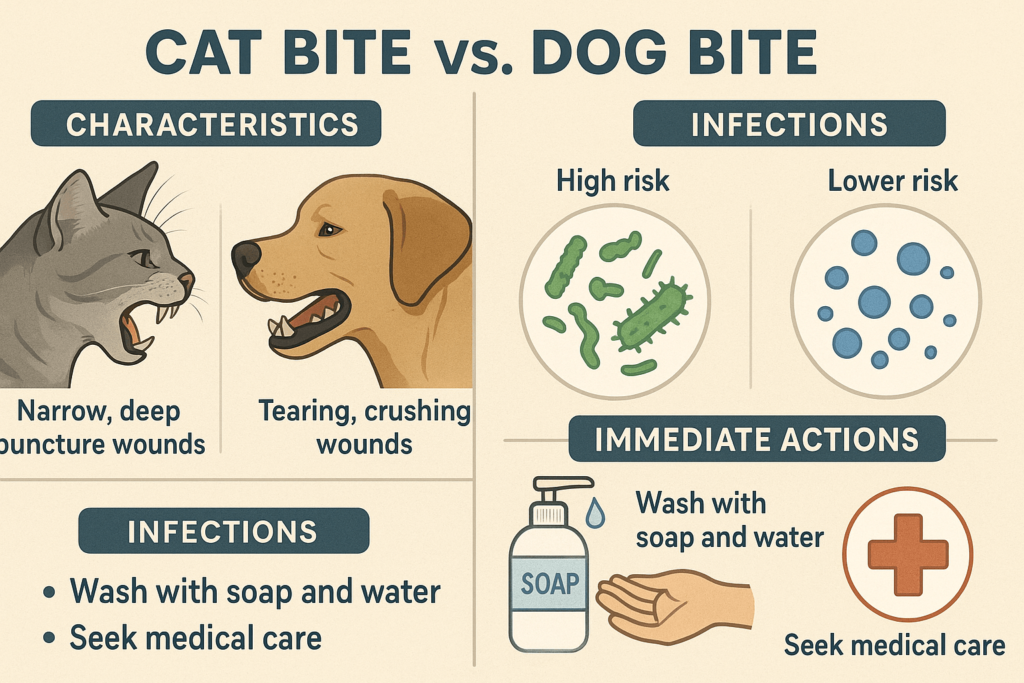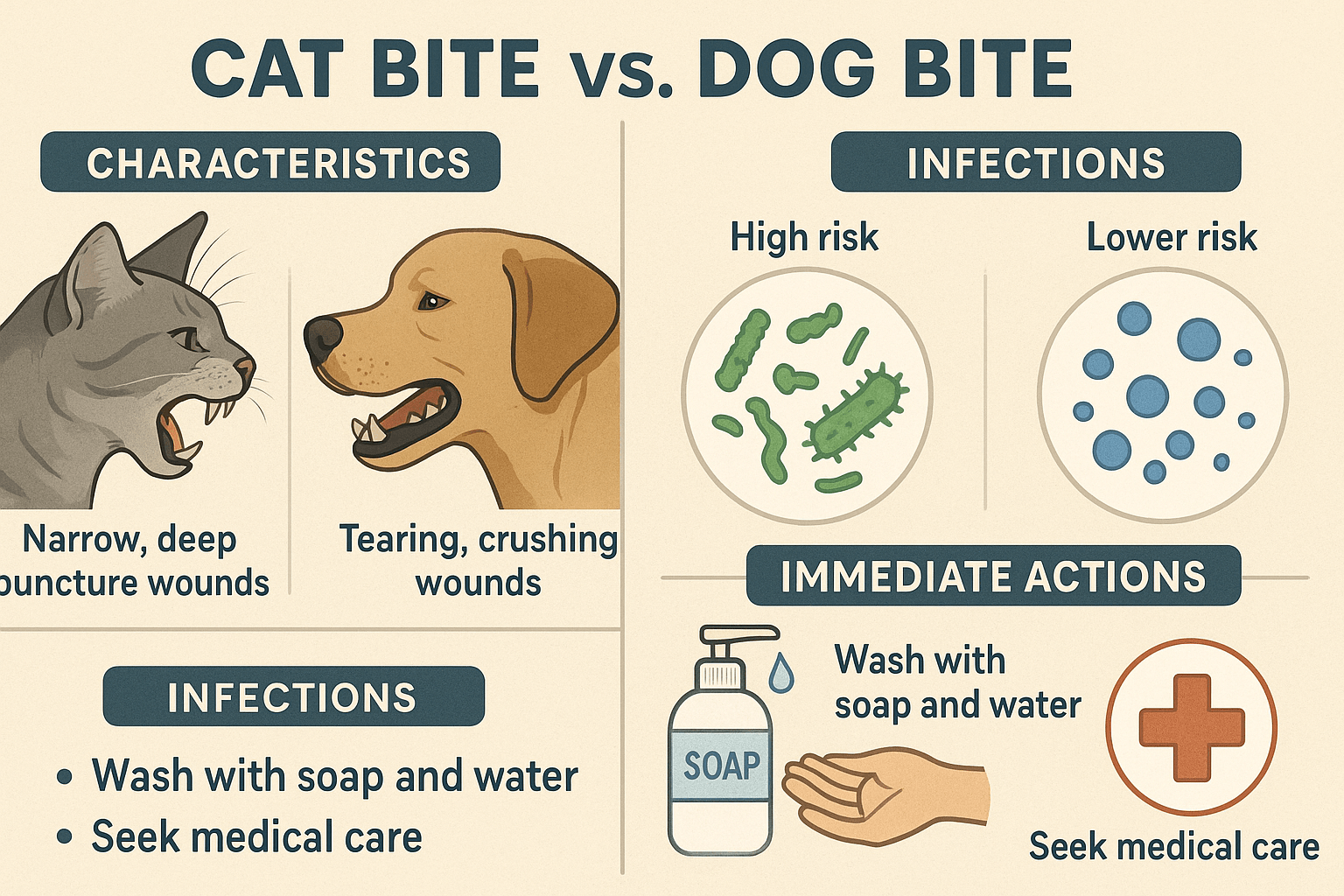Cat Bite vs Dog Bite: Understanding the Differences
Bites from animals are a common concern for pet owners and anyone who interacts with cats and dogs. While both cat bites and dog bites can cause injury, they differ significantly in terms of severity, risk of infection, and treatment requirements. Understanding these differences is crucial for ensuring proper care and preventing complications. Whether you’re dealing with a playful nip or a more serious incident, knowing how to respond can make all the difference. In this article, we’ll explore the key distinctions between cat bites and dog bites, their potential risks, and how to handle each situation effectively.
Key Characteristics of Cat Bites
Cat bites may seem less severe than dog bites due to their smaller size, but they carry unique risks that shouldn’t be underestimated. Here’s what you need to know about cat bites and their implications.
Sharp, Needle-Like Teeth:
Cats have thin, sharp teeth that can puncture deeply into the skin, often reaching underlying tissues and joints.High Risk of Infection:
The bacteria present in a cat’s mouth, such as Pasteurella multocida, can lead to serious infections if left untreated.Small Wounds That Heal Quickly:
Cat bite wounds may appear minor on the surface but can hide deeper tissue damage beneath the skin.Common Locations:
Hands and fingers are frequent targets of cat bites, which increases the risk of complications due to limited blood flow in these areas.Behavioral Triggers:
Cats typically bite out of fear, stress, or overstimulation during play, rather than aggression.
Understanding these characteristics helps explain why cat bites require prompt attention despite their seemingly minor appearance.

Key Characteristics of Dog Bites
Dog bites tend to be more visible and immediate in their impact compared to cat bites. However, their severity varies depending on factors like the size of the dog and the force of the bite.
Larger, More Visible Wounds:
Dog bites often result in torn skin, bruising, and significant lacerations due to their powerful jaws.Variable Risk of Infection:
While not as prone to deep-tissue infections as cat bites, dog bites still carry bacteria like Staphylococcus and Streptococcus.Potential for Severe Damage:
Large dogs or aggressive attacks can cause fractures, nerve damage, or even life-threatening injuries.Behavioral Triggers:
Dogs may bite due to territorial instincts, fear, pain, or improper socialization, making prevention critical.Legal Implications:
Dog bites often involve reporting requirements or liability issues, depending on local laws and regulations.
Recognizing these traits highlights the importance of addressing dog bites promptly and understanding their broader context.
Check this guide 👉Cat vs Dog Senses: Best 7 Expert Tips!
Check this guide 👉Cat Food vs Dog Food: Best 7 Expert Tips!
Check this guide 👉Cat Vision vs Dog Vision: Best 7 Expert Tips!
Cat Bite Risks | Dog Bite Risks |
|---|---|
High risk of deep-tissue infection | Risk of severe lacerations and trauma |
Small puncture wounds | Larger, more visible wounds |
Commonly affects hands and fingers | Can affect any part of the body |
Caused by fear or overstimulation | Triggered by territoriality or fear |
Requires antibiotics in most cases | May require stitches or surgery |
First Aid Steps for Animal Bites
Whether you’ve been bitten by a cat or a dog, immediate first aid is essential to minimize the risk of infection and promote healing. Follow these steps to address the injury effectively.
Clean the Wound Thoroughly:
Rinse the bite under warm running water for several minutes to remove dirt and bacteria.Apply Antiseptic Solution:
Use an antiseptic like hydrogen peroxide or iodine to disinfect the area and reduce the risk of infection.Control Bleeding:
Apply gentle pressure with a clean cloth or bandage to stop any bleeding before proceeding further.Cover the Wound:
Use a sterile dressing or bandage to protect the wound from additional contamination.Seek Medical Attention:
Visit a healthcare professional, especially if the bite is deep, shows signs of infection, or came from an unknown animal.
Proper first aid can prevent complications and ensure faster recovery after an animal bite.
Preventing Cat and Dog Bites
Prevention is always better than cure when it comes to animal bites. Taking proactive measures can help you avoid dangerous situations and keep both humans and pets safe.
Understand Animal Behavior:
Learn to recognize signs of fear, stress, or aggression in cats and dogs to avoid triggering unwanted reactions.Supervise Interactions with Children:
Teach children how to approach and interact with animals gently and respectfully.Socialize Your Pets:
Ensure your pets are well-socialized and accustomed to different environments and people to reduce anxiety-related biting.Avoid Provoking Animals:
Refrain from disturbing animals while they eat, sleep, or care for their young, as this can provoke defensive behavior.Use Protective Gear:
Wear gloves or protective clothing when handling unfamiliar or potentially aggressive animals.
By implementing these strategies, you can significantly reduce the likelihood of experiencing a cat or dog bite.
Signs of an Infected Bite
Recognizing the early signs of infection is vital for timely treatment and recovery. If you’ve been bitten by a cat or dog, watch for these symptoms that indicate a worsening condition.
Increased Redness Around the Wound:
Spreading redness beyond the initial bite area may signal an advancing infection.Swelling and Warmth:
Swollen, warm skin near the bite suggests inflammation caused by bacterial growth.Pus or Discharge:
Yellow or green discharge from the wound indicates the presence of infection.Fever and Fatigue:
Systemic symptoms like fever and fatigue could mean the infection has spread throughout the body.Delayed Healing:
A bite that doesn’t improve within a few days despite care requires medical evaluation.
Identifying these signs ensures prompt treatment and prevents further complications.
Legal Considerations After a Dog Bite
If you or someone else experiences a dog bite, legal considerations may arise depending on the circumstances. Understanding your rights and responsibilities can help navigate these situations effectively.
Reporting Requirements:
Many regions mandate reporting dog bites to local authorities to track potentially dangerous animals.Owner Liability Laws:
Some areas hold dog owners strictly liable for injuries caused by their pets, regardless of negligence.Documentation of the Incident:
Take photos of the wound, gather witness statements, and keep records of medical expenses for future reference.Insurance Claims:
Homeowner’s or renter’s insurance policies may cover damages resulting from dog bites, so check coverage details.Court Action in Severe Cases:
For serious injuries, pursuing legal action against the owner might be necessary to recover compensation.
Being informed about legal aspects helps protect your interests after a dog bite incident.
Training Tips to Prevent Aggressive Behavior
Preventing aggressive behavior in pets reduces the risk of bites and fosters a safer environment for everyone. These training tips can help curb aggression in both cats and dogs.
Positive Reinforcement:
Reward calm and non-aggressive behaviors with treats, praise, or toys to encourage good habits.Desensitization Exercises:
Gradually expose your pet to triggers that cause fear or aggression in controlled settings to build tolerance.Obedience Training for Dogs:
Teaching basic commands like “sit,” “stay,” and “leave it” improves control and reduces impulsive actions.Provide Mental Stimulation:
Engage your pet with puzzles, interactive toys, or games to reduce boredom-related aggression.Consult a Professional Trainer:
Seek guidance from a certified trainer or behaviorist if your pet exhibits persistent aggression or fear-based responses.
With consistent effort and patience, you can train your pet to behave confidently and calmly in various situations.
Frequently Asked Questions About Cat and Dog Bites
Are cat bites more dangerous than dog bites?
Cat bites pose a higher risk of deep-tissue infections, while dog bites are more likely to cause severe physical trauma.
Do I need a tetanus shot after an animal bite?
Yes, if your tetanus vaccine is not up-to-date, you should get a booster shot following a bite.
Can I treat a minor bite at home?
Minor bites can be treated at home with proper cleaning, but consult a doctor if there are signs of infection or if the bite was from an unfamiliar animal.
What should I do if bitten by a stray animal?
Clean the wound immediately and seek medical attention to assess the need for rabies prophylaxis.
How can I tell if a bite is infected?
Signs of infection include redness, swelling, pus, warmth around the wound, and fever.
Staying Safe Around Cats and Dogs
Both cat bites and dog bites come with unique risks and challenges, but understanding their differences empowers you to respond effectively and minimize harm. By practicing preventive measures, administering proper first aid, and seeking medical care when necessary, you can protect yourself and your loved ones from potential complications. Remember, responsible pet ownership and respectful interactions go a long way in fostering harmony between humans and animals. With knowledge and awareness, you can enjoy the companionship of cats and dogs while staying safe and prepared for any situation.
Understanding Cryptosporidium in Cats: Best 7 Expert Tips! – Spot symptoms, treat safely, and stop parasite spread in your home.
Understanding Cryptosporidium in Dogs: Best 7 Expert Tips! – Learn symptoms, treatment & prevention for this stubborn gut parasite.
Understanding Syringomyelia in Cats: Best 7 Expert Tips! – Recognize signs, manage pain, and support your cat’s neurological health with vet-backed guidance.
Understanding Syringomyelia in Dogs: Best 7 Expert Tips! – Expert insights on symptoms, MRI diagnosis, pain management & quality of life.





